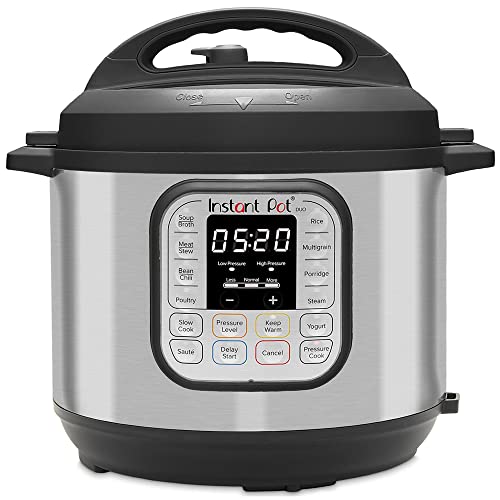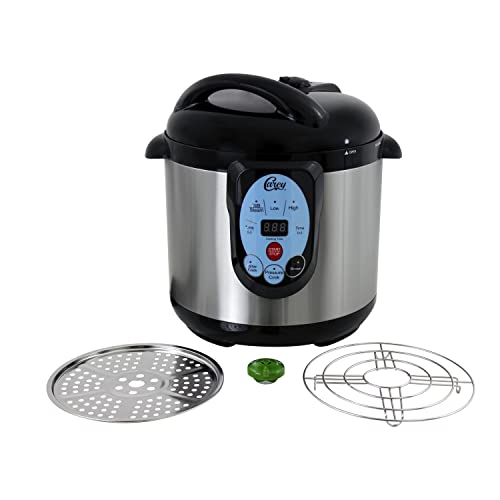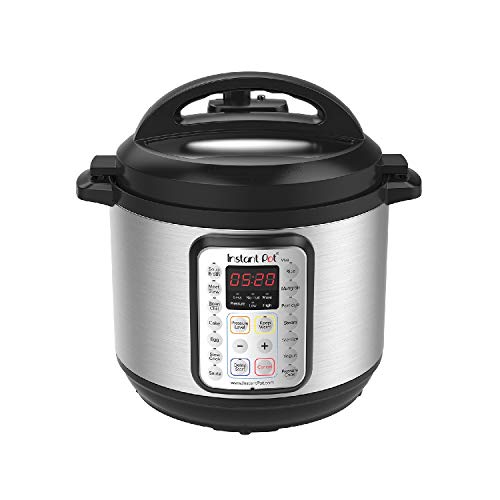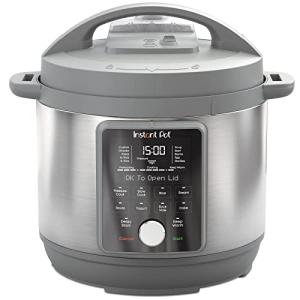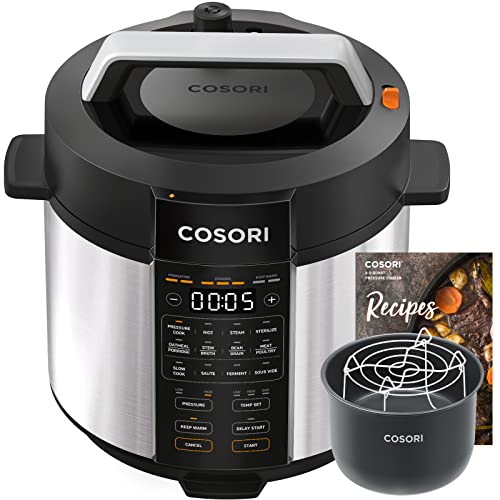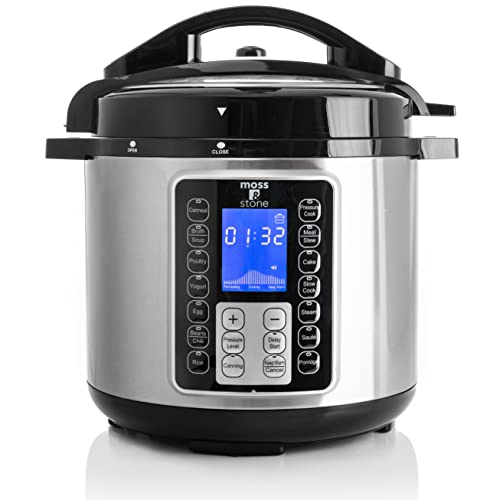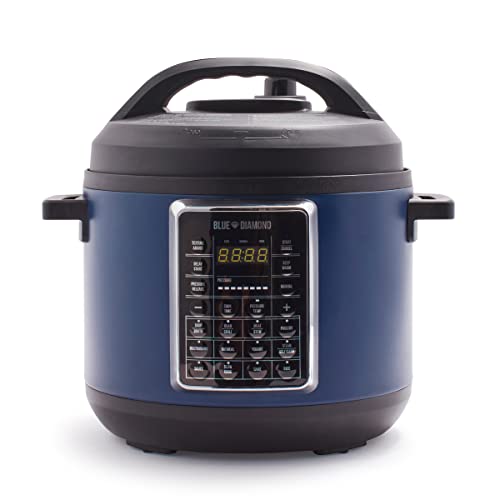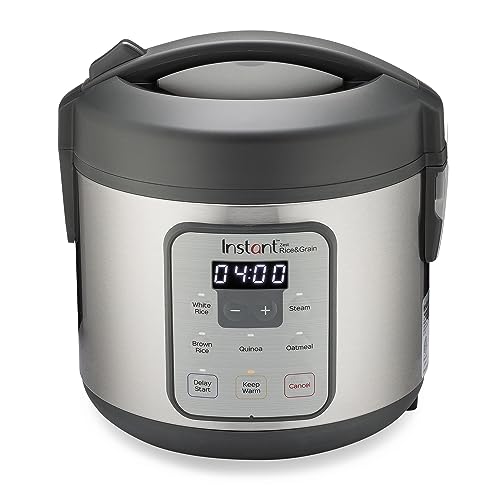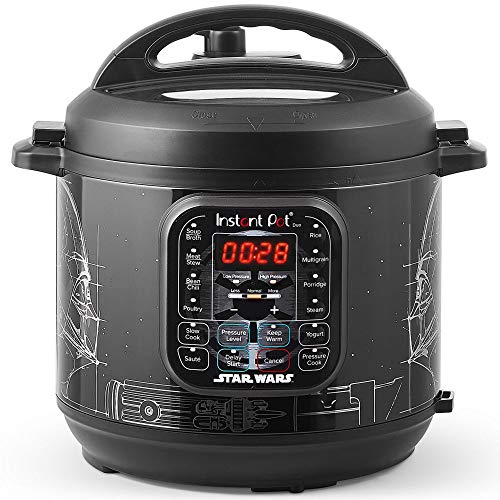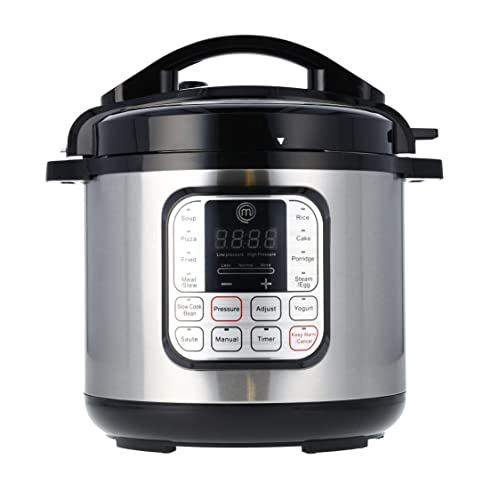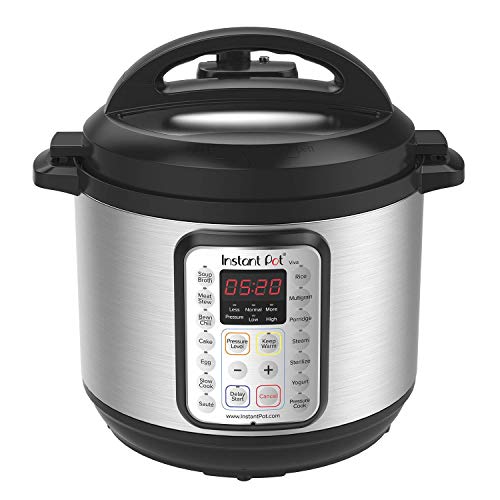Understanding Electric Pressure Cookers
What is an Electric Pressure Cooker?
An electric pressure cooker is a modern kitchen appliance that combines the functions of a traditional pressure cooker with the convenience of automation. It uses electricity to generate heat and pressure to cook food quickly and efficiently.
Explanation of the Technology Behind Electric Pressure Cookers
Electric pressure cookers operate on the principle of sealed cooking, where steam pressure builds up inside the pot to raise the boiling point of water, thus cooking food faster. They typically consist of a stainless steel or aluminum cooking pot, a heating element, a pressure sensor, and a control panel. The control panel allows users to adjust cooking settings such as pressure levels, cooking time, and temperature.
Comparison with Traditional Pressure Cookers
Compared to traditional stovetop pressure cookers, electric pressure cookers offer greater convenience and safety features. They eliminate the need for constant monitoring and manual adjustment of heat, as they regulate temperature and pressure automatically. Additionally, electric pressure cookers often come with programmable features and preset cooking programs for various dishes, making them more user-friendly.
Key Features and Innovations
1. Digital Timers:
Electric pressure cookers are equipped with digital timers that allow users to set precise cooking times. This feature ensures accurate cooking and prevents overcooking or undercooking of food.
2. Preset Cooking Programs:
Many electric pressure cookers come with preset cooking programs for popular dishes such as rice, soup, stew, and yogurt. These programs adjust cooking parameters automatically, simplifying the cooking process for users.
3. Keep-Warm Functions:
After cooking is complete, electric pressure cookers can automatically switch to a keep-warm mode to maintain the temperature of the food until it is ready to be served. This feature is convenient for busy households and prevents food from getting cold.
Discussion of Safety Features and How They've Evolved
Electric pressure cookers incorporate various safety features to prevent accidents and ensure user safety. These include:
1. Pressure Release Valves:
Modern electric pressure cookers are equipped with multiple pressure release valves that regulate the release of steam to prevent excess pressure buildup. These valves ensure that the cooker remains within safe operating limits.
2. Lid Locking Mechanisms:
Electric pressure cookers feature lid locking mechanisms that prevent the lid from being opened while there is pressure inside the cooker. This prevents accidental burns or spills.
3. Overheat Protection:
Built-in sensors monitor the temperature inside the cooker and automatically shut off the heating element if it exceeds safe levels. This protects against overheating and potential fire hazards.
4. Automatic Pressure Control:
Electric pressure cookers have sensors that monitor internal pressure levels and adjust heat output accordingly to maintain safe pressure levels. This helps prevent explosions or other pressure-related accidents.
Overall, the safety features of electric pressure cookers have evolved significantly over time, making them reliable and secure appliances for modern kitchens.
Benefits of Using an Electric Pressure Cooker
Time Efficiency
Electric pressure cookers excel in reducing cooking times for a variety of dishes, making meal preparation significantly faster compared to conventional methods. Here are some examples:
Beans and Legumes: Cooking beans and legumes traditionally can take hours, but with an electric pressure cooker, they can be cooked to perfection in a fraction of the time, usually within 30 minutes.
Tough Cuts of Meat: Tough cuts of meat that typically require long hours of braising or stewing can be tenderized and cooked in a matter of minutes in an electric pressure cooker.
Rice and Grains: Rice, quinoa, and other grains cook much faster under pressure, with cooking times often reduced by half compared to stovetop methods.
Energy Efficiency
Electric pressure cookers are remarkably energy-efficient when compared to conventional cooking methods, primarily due to their ability to cook food quickly and with less water. Here's how they stack up:
Reduced Cooking Time: Since electric pressure cookers cook food in a fraction of the time required for conventional methods, they use less energy overall. This can lead to significant energy savings, especially for long-cooking dishes like stews and soups.
Sealed Cooking Environment: The sealed cooking environment of electric pressure cookers traps heat and steam, allowing food to cook efficiently without losing heat to the surrounding environment. This reduces energy waste and helps maintain a consistent cooking temperature.
Nutritional Benefits
Cooking under pressure in an electric pressure cooker can help preserve nutrients in food better than traditional cooking methods. Here's how:
Shorter Cooking Time: The shorter cooking times in electric pressure cookers help retain more vitamins and minerals in food compared to prolonged cooking methods, which can lead to nutrient loss through heat exposure.
Minimal Water Usage: Electric pressure cookers require less water for cooking compared to conventional methods like boiling or steaming. This helps prevent water-soluble vitamins and minerals from leaching out into the cooking liquid.
Convenience and Versatility
Electric pressure cookers offer unparalleled convenience and versatility in the kitchen, making them a staple appliance for many households:
Ease of Use: With programmable settings and preset cooking programs, electric pressure cookers are incredibly user-friendly, even for novice cooks. Simply add ingredients, select the appropriate cooking program, and let the cooker do the rest.
Wide Range of Dishes: From soups and stews to risottos, curries, and even desserts, electric pressure cookers can handle a vast array of dishes. Their versatility allows users to experiment with different recipes and cuisines with ease.
One-Pot Cooking: Many electric pressure cooker recipes involve one-pot cooking, where all ingredients are added to the cooker at once. This not only simplifies the cooking process but also reduces cleanup time, making meal preparation even more convenient.
How to Use an Electric Pressure Cooker
Getting Started
Using an electric pressure cooker is straightforward, but it's essential to familiarize yourself with its basic setup and operation:
Setup: Place the cooking pot inside the pressure cooker base and ensure it's properly seated. Add ingredients according to your recipe.
Locking the Lid: Close the lid securely by aligning the arrows or markings on the lid and the base. Some models require twisting the lid to lock it in place.
Selecting Cooking Settings: Use the control panel to choose the desired cooking program, pressure level, and cooking time. Follow your recipe or refer to the cooker's manual for specific settings.
Starting the Cooking Process: Once settings are selected, press the start button to begin the cooking cycle. The pressure cooker will preheat and build pressure before starting the countdown timer.
Releasing Pressure: After cooking is complete, use the quick-release or natural-release method to release pressure according to your recipe's instructions. Be cautious of steam when releasing pressure.
Safety Tips
Safety is paramount when using an electric pressure cooker. Follow these guidelines to ensure safe operation:
Read the Manual: Familiarize yourself with the manufacturer's instructions and safety guidelines provided in the user manual.
Inspect Seals and Valves: Before each use, check the sealing ring and pressure release valves for any damage or debris that could affect their functionality.
Avoid Overfilling: Never fill the pressure cooker beyond the recommended maximum fill line to prevent food from blocking the pressure release valves and causing excess pressure buildup.
Use Proper Ventilation: Always operate the pressure cooker in a well-ventilated area to prevent steam from accumulating and causing potential hazards.
Handle with Care: Exercise caution when handling the pressure cooker, especially when releasing pressure or removing the lid after cooking to avoid burns from steam.
Maintenance and Cleaning
Proper maintenance and cleaning are essential for the longevity of your electric pressure cooker:
Regular Cleaning: After each use, remove the cooking pot and wash it with warm, soapy water. Wipe the exterior of the pressure cooker with a damp cloth to remove any spills or stains.
Clean Sealing Ring and Valves: Periodically remove and clean the sealing ring and pressure release valves to prevent odor buildup and ensure proper sealing and pressure release.
Descaling: If mineral deposits accumulate on the cooking pot or interior surfaces, descale them using a mixture of vinegar and water or a descaling solution recommended by the manufacturer.
Storage: Store the pressure cooker in a cool, dry place with the lid removed to allow air circulation and prevent moisture buildup.
Troubleshooting Common Issues
If you encounter any problems or errors while using your electric pressure cooker, here are some troubleshooting tips:
Error Codes: Refer to the user manual to interpret error codes displayed on the control panel. Error codes often indicate issues such as overheating, low pressure, or sensor malfunctions.
Check Seals and Valves: If the pressure cooker fails to pressurize or maintain pressure, check the sealing ring and pressure release valves for proper alignment and cleanliness.
Adjust Cooking Settings: If food is consistently overcooked or undercooked, adjust cooking times, pressure levels, or temperature settings to achieve desired results.
Contact Customer Support: If troubleshooting steps fail to resolve the issue, contact the manufacturer's customer support for assistance or to inquire about warranty coverage.
Cooking with an Electric Pressure Cooker
Recipe Adaptation
Adapting traditional recipes for an electric pressure cooker can yield delicious results with a fraction of the time. Here are some tips to ensure successful adaptation:
Adjust Liquid Levels: Reduce the amount of liquid called for in traditional recipes, as pressure cooking requires less liquid due to minimal evaporation.
Modify Cooking Times: Decrease cooking times by approximately 70% to 80% compared to conventional methods. Start with the recommended cooking time for similar ingredients in pressure cooker recipes and adjust as needed.
Consider Ingredient Placement: Layer ingredients wisely, placing denser items at the bottom and lighter items on top to ensure even cooking.
Avoid Dairy and Thickening Agents: Add dairy products and thickening agents like flour or cornstarch after pressure cooking to prevent them from curdling or causing thickening issues.
Must-Try Recipes
Beginner-friendly recipes are perfect for those new to electric pressure cooking. Here are some popular options to get you started:
Beef Stew: Tender chunks of beef, carrots, potatoes, and onions simmered in a savory broth. Cooked under pressure, this comforting stew is ready in under an hour.
Chicken and Rice: Juicy chicken thighs, fragrant rice, and flavorful seasonings cooked together for a one-pot meal that's both satisfying and easy to make.
Vegetable Soup: A medley of fresh vegetables, broth, and herbs come together in a hearty soup that's perfect for chilly days. Customize with your favorite veggies for a nutritious meal.
Pulled Pork: Succulent pork shoulder seasoned with spices and slow-cooked until tender. Finish with your favorite barbecue sauce for irresistible pulled pork sandwiches.
Advanced Techniques
For seasoned users looking to expand their electric pressure cooker repertoire, consider these advanced techniques:
Sauté Function: Utilize the sauté function to brown meats or vegetables before pressure cooking, adding depth of flavor to dishes like chili, curry, or risotto.
Pot-in-Pot Cooking: Experiment with pot-in-pot cooking by placing a smaller container inside the pressure cooker cooking pot. This technique is perfect for cooking rice, desserts, or delicate foods that require separate cooking vessels.
Pressure Canning: Some electric pressure cookers offer pressure canning capabilities, allowing you to safely preserve fruits, vegetables, and homemade sauces for long-term storage.
Homemade Yogurt: Make creamy, tangy yogurt at home using your electric pressure cooker's yogurt function. With precise temperature control, it's easy to achieve perfect yogurt every time.
By mastering these techniques and trying new recipes, you'll unlock the full potential of your electric pressure cooker and create delicious meals with ease.
Comparisons and Considerations
Electric Pressure Cooker vs. Slow Cooker
Both electric pressure cookers and slow cookers offer convenience in the kitchen, but they have distinct differences:
Cooking Time: Electric pressure cookers excel in reducing cooking time significantly compared to slow cookers. Pressure cooking can tenderize tough cuts of meat and cook beans in a fraction of the time required by slow cooking methods.
Versatility: While slow cookers are ideal for long, slow cooking, electric pressure cookers offer versatility with the ability to sauté, steam, and even bake in addition to pressure cooking. This makes them suitable for a wider range of recipes and cooking techniques.
Flavor and Texture: Electric pressure cookers can preserve more flavor and nutrients due to shorter cooking times, whereas slow cookers are known for producing rich, deeply flavored dishes with tender meats and vegetables.
Cost Analysis
Electric pressure cookers typically range in price from $50 to $200, depending on brand, size, and features. While the initial investment may seem higher than that of a slow cooker, the value for money lies in the time saved and versatility offered by electric pressure cookers.
Considering the cost of ingredients and the potential savings on energy bills due to shorter cooking times, electric pressure cookers offer a compelling value proposition for busy households looking to streamline meal preparation.
Choosing the Right Model
When selecting an electric pressure cooker, several factors should be considered:
Size: Choose a size that suits your household's needs, whether you're cooking for one or feeding a large family. Most electric pressure cookers come in 6-quart or 8-quart sizes.
Features: Look for features such as preset cooking programs, adjustable pressure settings, and safety features like lid-locking mechanisms and automatic pressure release valves.
Brand Reputation: Research reputable brands known for quality construction, reliability, and excellent customer support.
The Electric Pressure Cooker
In conclusion, electric pressure cookers are revolutionizing modern cooking practices by offering time-saving convenience, versatility, and nutritious meal options. With their ability to cook quickly and efficiently, they're empowering home cooks to prepare healthy and flavorful meals with ease.
Have you tried cooking with an electric pressure cooker? Share your experiences, favorite recipes, or tips for using this versatile kitchen appliance. We'd love to hear from you!
Additionally, if you have any suggestions for future articles on kitchen gadgets or topics you'd like to learn more about, please share them with us. Your feedback is invaluable in helping us create content that resonates with our readers.
